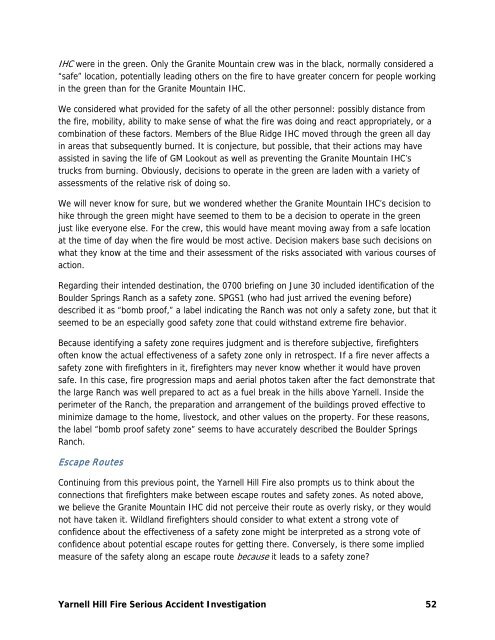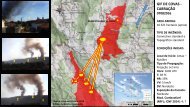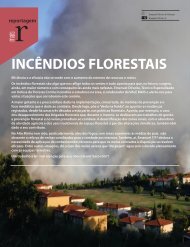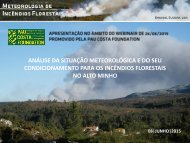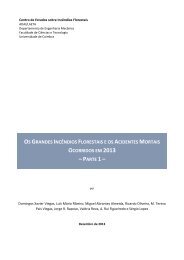Relatório do Acidente ocorrido no Incêndio Florestal de Yarnel Hill
Neste incêndio, de 30 de Junho de 2013, morreram 19 combatentes florestais da equipa "Hot Shot" de Granite Mountain.
Neste incêndio, de 30 de Junho de 2013, morreram 19 combatentes florestais da equipa "Hot Shot" de Granite Mountain.
Create successful ePaper yourself
Turn your PDF publications into a flip-book with our unique Google optimized e-Paper software.
IHC were in the green. Only the Granite Mountain crew was in the black, <strong>no</strong>rmally consi<strong>de</strong>red a<br />
“safe” location, potentially leading others on the fire to have greater concern for people working<br />
in the green than for the Granite Mountain IHC.<br />
We consi<strong>de</strong>red what provi<strong>de</strong>d for the safety of all the other personnel: possibly distance from<br />
the fire, mobility, ability to make sense of what the fire was <strong>do</strong>ing and react appropriately, or a<br />
combination of these factors. Members of the Blue Ridge IHC moved through the green all day<br />
in areas that subsequently burned. It is conjecture, but possible, that their actions may have<br />
assisted in saving the life of GM Lookout as well as preventing the Granite Mountain IHC’s<br />
trucks from burning. Obviously, <strong>de</strong>cisions to operate in the green are la<strong>de</strong>n with a variety of<br />
assessments of the relative risk of <strong>do</strong>ing so.<br />
We will never k<strong>no</strong>w for sure, but we won<strong>de</strong>red whether the Granite Mountain IHC’s <strong>de</strong>cision to<br />
hike through the green might have seemed to them to be a <strong>de</strong>cision to operate in the green<br />
just like everyone else. For the crew, this would have meant moving away from a safe location<br />
at the time of day when the fire would be most active. Decision makers base such <strong>de</strong>cisions on<br />
what they k<strong>no</strong>w at the time and their assessment of the risks associated with various courses of<br />
action.<br />
Regarding their inten<strong>de</strong>d <strong>de</strong>stination, the 0700 briefing on June 30 inclu<strong>de</strong>d i<strong>de</strong>ntification of the<br />
Boul<strong>de</strong>r Springs Ranch as a safety zone. SPGS1 (who had just arrived the evening before)<br />
<strong>de</strong>scribed it as “bomb proof,” a label indicating the Ranch was <strong>no</strong>t only a safety zone, but that it<br />
seemed to be an especially good safety zone that could withstand extreme fire behavior.<br />
Because i<strong>de</strong>ntifying a safety zone requires judgment and is therefore subjective, firefighters<br />
often k<strong>no</strong>w the actual effectiveness of a safety zone only in retrospect. If a fire never affects a<br />
safety zone with firefighters in it, firefighters may never k<strong>no</strong>w whether it would have proven<br />
safe. In this case, fire progression maps and aerial photos taken after the fact <strong>de</strong>monstrate that<br />
the large Ranch was well prepared to act as a fuel break in the hills above <strong>Yarnel</strong>l. Insi<strong>de</strong> the<br />
perimeter of the Ranch, the preparation and arrangement of the buildings proved effective to<br />
minimize damage to the home, livestock, and other values on the property. For these reasons,<br />
the label “bomb proof safety zone” seems to have accurately <strong>de</strong>scribed the Boul<strong>de</strong>r Springs<br />
Ranch.<br />
Escape Routes<br />
Continuing from this previous point, the <strong>Yarnel</strong>l <strong>Hill</strong> Fire also prompts us to think about the<br />
connections that firefighters make between escape routes and safety zones. As <strong>no</strong>ted above,<br />
we believe the Granite Mountain IHC did <strong>no</strong>t perceive their route as overly risky, or they would<br />
<strong>no</strong>t have taken it. Wildland firefighters should consi<strong>de</strong>r to what extent a strong vote of<br />
confi<strong>de</strong>nce about the effectiveness of a safety zone might be interpreted as a strong vote of<br />
confi<strong>de</strong>nce about potential escape routes for getting there. Conversely, is there some implied<br />
measure of the safety along an escape route because it leads to a safety zone?<br />
<strong>Yarnel</strong>l <strong>Hill</strong> Fire Serious Acci<strong>de</strong>nt Investigation 52


